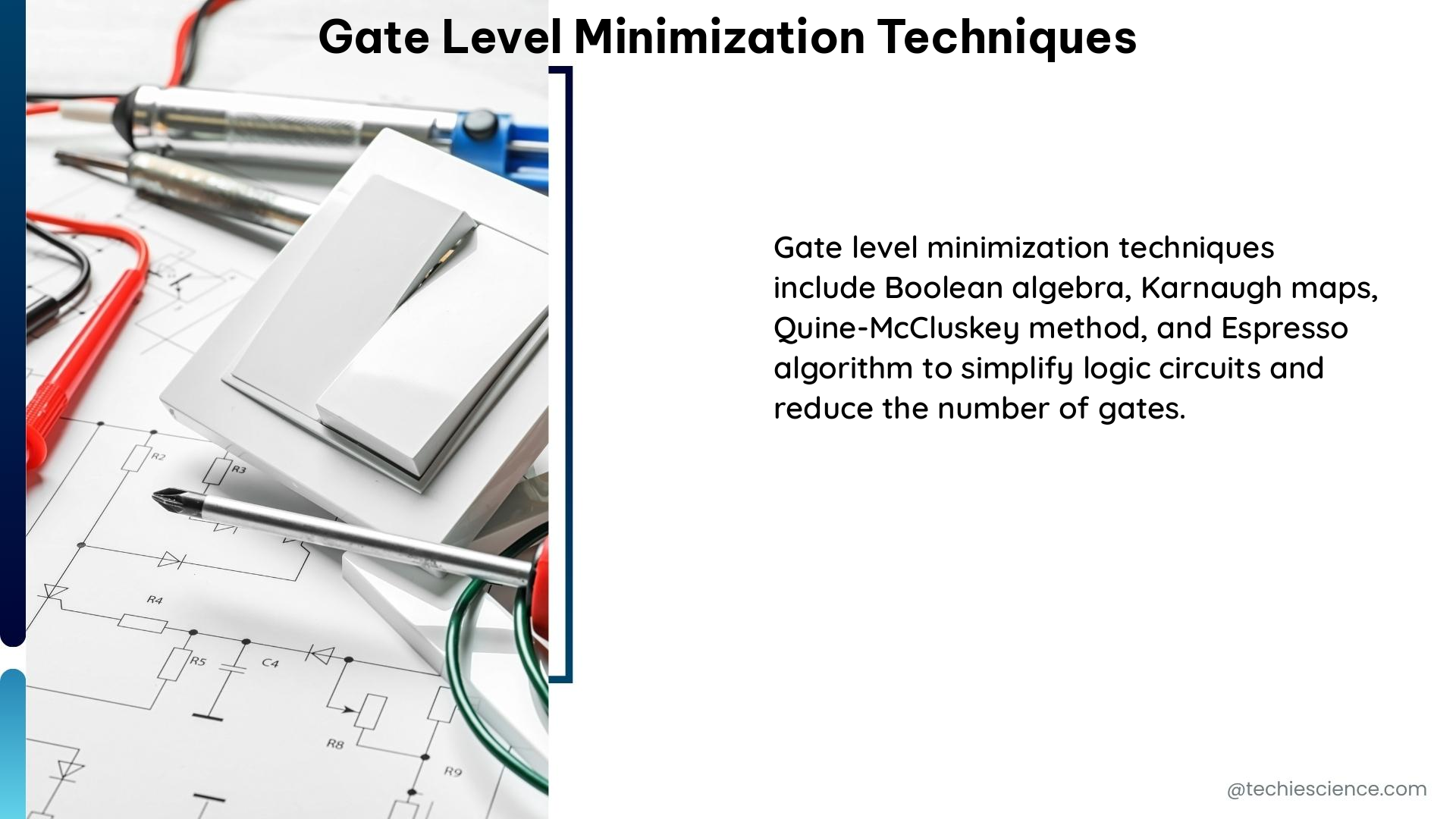Gate level minimization techniques are essential in the design and optimization of digital circuits, as they aim to reduce the complexity and improve the efficiency of these circuits. By minimizing the number of gates and literals used in the implementation, gate level minimization techniques can lead to significant improvements in various performance metrics, such as delay, power consumption, area, cost, and reliability.
Understanding Gate Level Minimization
Gate level minimization is the process of simplifying a digital circuit by reducing the number of logic gates and the number of literals (inputs and inversions) used in its implementation. This is achieved through the application of Boolean algebra and logic minimization algorithms, such as Karnaugh maps, Quine-McCluskey, and Espresso.
The primary goal of gate level minimization is to create a more efficient and cost-effective digital circuit by reducing the overall complexity of the design. This can be quantified through various measurable data points, including:
- Number of Gates: The most direct measure of circuit complexity, a gate level minimized circuit will have fewer gates compared to its unminimized counterpart.
- Number of Literals: The total number of inputs and inversions in a circuit, minimizing the number of literals can lead to a reduction in delay and power consumption.
- Delay: The time taken for a signal to propagate through a circuit, a gate level minimized circuit will have a lower delay, resulting in faster operation.
- Power Consumption: The amount of power consumed by a circuit during operation, a gate level minimized circuit will have lower power consumption, leading to longer battery life and reduced heat dissipation.
- Area: The physical area occupied by a circuit, a gate level minimized circuit will have a smaller area, resulting in a more compact and cost-effective design.
- Cost: The total cost of designing and manufacturing a circuit, a gate level minimized circuit will have a lower cost compared to an unminimized circuit.
- Reliability: The ability of a circuit to operate without failure, a gate level minimized circuit will have higher reliability, leading to a more robust design.
Techniques for Gate Level Minimization

There are several techniques and algorithms used for gate level minimization, each with its own strengths and weaknesses. The choice of technique depends on the complexity of the circuit, the desired optimization criteria, and the available computational resources.
Karnaugh Maps
Karnaugh maps are a graphical method for simplifying Boolean expressions. They are particularly useful for small-scale circuits with up to six variables. Karnaugh maps work by grouping adjacent 1’s in the map to identify the essential prime implicants, which are then used to construct the minimized Boolean expression.
Advantages:
– Intuitive and easy to understand
– Effective for small-scale circuits
– Provides a visual representation of the Boolean function
Limitations:
– Limited to circuits with up to six variables
– Can become unwieldy for larger circuits
– Requires manual manipulation and analysis
Quine-McCluskey Algorithm
The Quine-McCluskey algorithm is a systematic method for minimizing Boolean expressions. It works by generating a table of all possible prime implicants and then selecting the essential prime implicants to construct the minimized Boolean expression.
Advantages:
– Suitable for larger circuits with more variables
– Systematic and less prone to human error
– Can be automated and implemented in software
Limitations:
– Can be computationally intensive for large circuits
– Requires careful management of the prime implicant table
Espresso Algorithm
Espresso is a heuristic algorithm for minimizing Boolean expressions. It works by iteratively simplifying the Boolean expression, using a series of operations such as extraction, expansion, and reduction.
Advantages:
– Highly effective for large-scale circuits
– Can handle complex Boolean expressions
– Provides a good balance between speed and optimality
Limitations:
– Can be sensitive to the initial input expression
– Requires careful tuning of the algorithm parameters
– May not always find the globally optimal solution
Practical Considerations
When applying gate level minimization techniques, there are several practical considerations to keep in mind:
- Circuit Complexity: The choice of minimization technique depends on the complexity of the circuit. Karnaugh maps are suitable for small-scale circuits, while Quine-McCluskey and Espresso are more appropriate for larger circuits.
- Optimization Criteria: The desired optimization criteria, such as delay, power, or area, can influence the choice of minimization technique and the specific parameters used.
- Design Constraints: Factors such as technology, power supply, and environmental conditions can impose additional constraints on the circuit design, which must be taken into account during the minimization process.
- Computational Resources: The available computational resources, such as processing power and memory, can limit the feasibility of certain minimization techniques, especially for large circuits.
- Design Automation Tools: Many electronic design automation (EDA) tools, such as logic synthesis and optimization software, incorporate gate level minimization algorithms and can automate the process.
Conclusion
Gate level minimization techniques are essential in the design and optimization of digital circuits, as they can lead to significant improvements in various performance metrics, including delay, power consumption, area, cost, and reliability. By understanding the different minimization techniques, their strengths and limitations, and the practical considerations involved, electronics engineers can create more efficient and cost-effective digital circuits.
References
- Introduction to Electronic Design Automation Logic Synthesis
- Gate-Level Minimization
- Gate Level Minimization Tutorial Part 1 – Digital Logic and Design – BA
- DOD Data Strategy – Department of Defense
- Minimization of Boolean Functions | GATE Notes – BYJU’S

The lambdageeks.com Core SME Team is a group of experienced subject matter experts from diverse scientific and technical fields including Physics, Chemistry, Technology,Electronics & Electrical Engineering, Automotive, Mechanical Engineering. Our team collaborates to create high-quality, well-researched articles on a wide range of science and technology topics for the lambdageeks.com website.
All Our Senior SME are having more than 7 Years of experience in the respective fields . They are either Working Industry Professionals or assocaited With different Universities. Refer Our Authors Page to get to know About our Core SMEs.